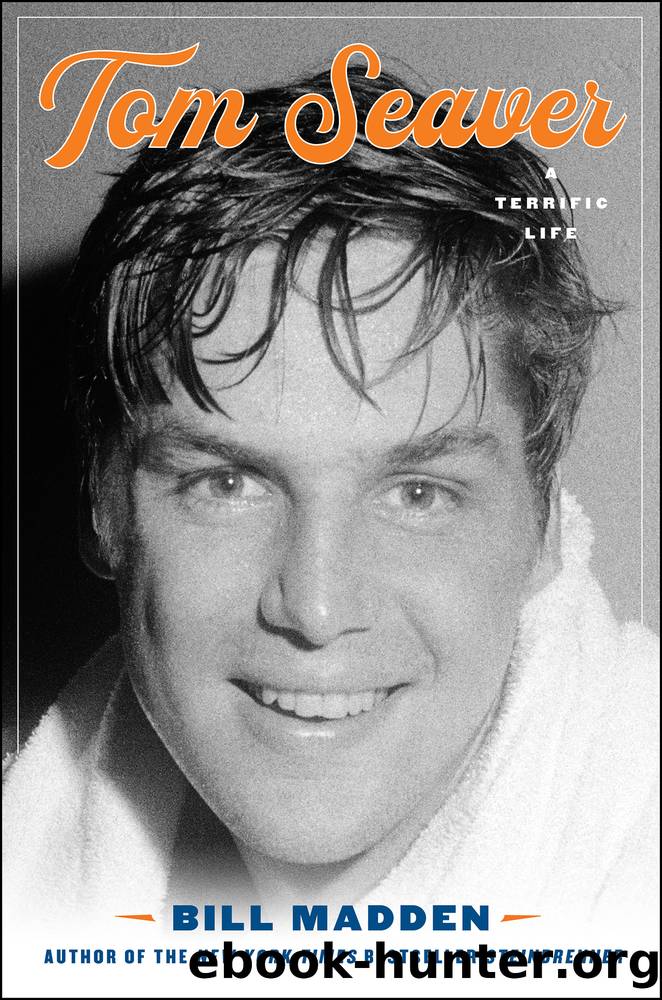Tom Seaver by Bill Madden

Author:Bill Madden
Language: eng
Format: epub
Publisher: Simon & Schuster
Published: 2020-11-24T00:00:00+00:00
* * *
The Metsâ disappointing 83-79 third-place finish in 1971, in which they ranked eighth in the twelve-team National League in runs, underscored the need for GM Scheffing to bolster the offense at the December baseball winter meetings in Phoenixâparticularly at third base, where Bob Aspromonte (.225, five homers) had proven to be as big a failure as Foy the year before.
By the time the meetings were about to conclude, a flurry of fifteen trades had been completed, not one of them involving the Mets. A group of Mets beat writers confronted M. Donald Grant in the lobby of the Arizona Biltmore Country Club and pleaded for him to make a deal.
âWeâre trying,â a visibly exasperated Grant said, shrugging, âbut it takes two.â
Five days after the meetings concluded, on December 10, Grant and Scheffing announced the completion of a five-player trade with the California Angels in which theyâd acquired twenty-nine-year-old Jim Fregosi, a six-time All-Star shortstop, in exchange for Nolan Ryan and three minor league prospects: outfielder Leroy Stanton, catcher Frank Estrada, and pitcher Don Rose. The plan was to move their new acquisition to third base, where no fewer than forty-five players had tried their hand during the franchiseâs ten-year existence.
In their desperation to appease the fans by landing a name player in Fregosi, the Metsâ high command had finally decided it could wait no longer for Seaverâs pal and rotation stablemate, the hard-throwing Ryan, to reach his vast potential. When Whitey Herzog, the former Mets farm director whoâd developed Ryan, heard about the deal, he was flabbergasted. âThey gave up Nolan plus three other players for Fregosi?â exclaimed Herzog, who, after being passed up by Grant for both the Metsâ manager and GM jobs, left the team at the end of the â71 season to take the Texas Rangersâ managing job. âI wouldnât have traded Stanton straight up for Fregosi!â
It was a pointed dig at his former boss that proved prophetic when Fregosi showed up overweight and out of shape at Mets spring training in 1972 and was yet another bust at third base with his poorest season: .232, 5 HR, 32 RBI in just 101 games. (Actually, after a career season in 1970 [.278, 22 HR, 82 RBI], Fregosi hit just .233 with five homers and 33 RBI in 107 games in â71, indicating his skills were already declining.) After an even less productive first half in â73, he was sold by the Mets to Texas in July. By contrast, as Seaver predicted, Ryan, whoâd never won more than 10 games for the Mets, came into his own in the laid-back baseball environment of Southern California. He won 19 for the Angels in 1972, leading the American League in strikeouts, and went on to become one of the greatest pitchers of all time, with 324 wins, a record 7 no-hitters, and 5,714 career strikeouts.
At the time of the four-for-one swap, Seaver expressed regret at the departure of his close friend but was also philosophical. âI think all
Download
This site does not store any files on its server. We only index and link to content provided by other sites. Please contact the content providers to delete copyright contents if any and email us, we'll remove relevant links or contents immediately.
The Ultimate Backcountry Survival Manual by Aram Von Benedikt; Editors of Outdoor Life;(2975)
Never by Ken Follett(2880)
Liar's Poker by Michael Lewis(2812)
Machine Learning at Scale with H2O by Gregory Keys | David Whiting(2291)
Will by Will Smith(2042)
The Partner by John Grisham(1982)
Taste by Kris Bryant(1614)
Friends, Lovers, and the Big Terrible Thing by Matthew Perry(1328)
The Arm by Jeff Passan(1302)
A Short History of War by Jeremy Black(1300)
The Dodgers by Schiavone Michael;(1299)
HBR's 10 Must Reads 2022 by Harvard Business Review(1256)
Can't Hurt Me: Master Your Mind and Defy the Odds - Clean Edition by David Goggins(1227)
515945210 by Unknown(1208)
The Yogi Book by Yogi Berra(1200)
1942266391 (N) by Monte Francis(1174)
Road Games by Road Games(1130)
Moneyball by Michael Lewis(1102)
This Family Does It by Kevin Sellers(1080)
